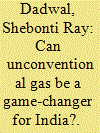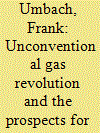|
|
|
Sort Order |
|
|
|
Items / Page
|
|
|
|
|
|
|
| Srl | Item |
| 1 |
ID:
150353


|
|
|
|
|
| Summary/Abstract |
China is vigorously promoting the development of its unconventional gas resources because natural gas is viewed as a lower-carbon energy source and because China has relatively little conventional natural gas supply. In this paper, we first evaluate how much unconventional gas might be available based on an analysis of technically recoverable resources for three types of unconventional gas resources: shale gas, coalbed methane and tight gas. We then develop three alternative scenarios of how this extraction might proceed, using the Geologic Resources Supply Demand Model. Based on our analysis, the medium scenario, which we would consider to be our best estimate, shows a resource peak of 176.1 billion cubic meters (bcm) in 2068. Depending on economic conditions and advance in extraction techniques, production could vary greatly from this. If economic conditions are adverse, unconventional natural gas production could perhaps be as low as 70.1 bcm, peaking in 2021. Under the extremely optimistic assumption that all of the resources that appear to be technologically available can actually be recovered, unconventional production could amount to as much as 469.7 bcm, with peak production in 2069. Even if this high scenario is achieved, China’s total gas production will only be sufficient to meet China’s lowest demand forecast. If production instead matches our best estimate, significant amounts of natural gas imports are likely to be needed.
|
|
|
|
|
|
|
|
|
|
|
|
|
|
|
|
| 2 |
ID:
123591


|
|
|
|
|
| Publication |
2013.
|
| Summary/Abstract |
We bring together a collection of papers that were presented at the inaugural event of the Asia-Europe Energy Policy Research Network (AEEPRN), held at Singapore in May 2012. The idea for creating AEEPRN was in response to the growing importance of energy in Asia and Europe's relations and to our shared belief that energy will become a more significant aspect of these relations over the forthcoming years and decades. The papers presented here cover the following themes: wind energy, biofuels, natural gas and gas pipelines, exergy and manufacturing, green energy co-operation, coal, unconventional gas and solar energy.
|
|
|
|
|
|
|
|
|
|
|
|
|
|
|
|
| 3 |
ID:
111283


|
|
|
|
|
| Publication |
2012.
|
| Summary/Abstract |
The discovery of extracting unconventional (shale) gas through hydraulic fracturing has revolutionised the gas industry in the US and has given rise to a debate over whether it has the potential to reverse the emerging geopolitical equations in the global energy sector which was hitherto seen to be tilting in favour of the conventional energy producers. This article will attempt to analyse what this means for India's energy security, whether the presence of substantial unconventional gas resources has the potential to alleviate India's energy dilemma and what impact it could have on India's overall energy policy.
|
|
|
|
|
|
|
|
|
|
|
|
|
|
|
|
| 4 |
ID:
150349


|
|
|
|
|
| Summary/Abstract |
In the US, the shale gas revolution ensured that the development costs of unconventional natural gas plummeted to the levels of $2–3/Mcf. This success has motivated the development of shale gas in other regions, including Australia and Europe. This study, focussing primarily on aspects of economic impact analysis, estimates the development costs of shale gas extraction in both Australia and Europe, based on both direct and fiscal costs, and also suggests policy initiatives.
|
|
|
|
|
|
|
|
|
|
|
|
|
|
|
|
| 5 |
ID:
127196


|
|
|
|
|
| Publication |
2014.
|
| Summary/Abstract |
Exploitation of unconventional gas is limited by a number of economic, legal, environmental and social factors. When it comes to Poland, legal and environmental factors are of special importance, as they might significantly impact the exploitation of both tight gas and shale gas.
Exploitation of unconventional gas deposits, because of the technology needed for opening of these deposits, has relatively great impact on the balance sheet and the quality of water. Polish water resources are limited and depend on time and local circumstances. Therefore, obtaining adequate amounts of water needed to hydraulic fracturing of unconventional gas reservoirs may cause some problems. Another problem is return water management. Injection of contaminated water into the rockmass on a large scale seems to be impossible in Poland. Water discharge to surface waters, which seems to be the most probable solution, would result in deterioration of the purity of Polish rivers.
Around 32% of Poland is covered by different forms of protection, which might include limitations in exploitation of hydrocarbon deposits (depending on the type of area).
Exploration, documentation and exploitation of unconventional gas in Poland is regulated mainly by the laws and regulations regulating geological and mining activities, environmental protection and waste management.
|
|
|
|
|
|
|
|
|
|
|
|
|
|
|
|
| 6 |
ID:
117342


|
|
|
|
|
| Publication |
2013.
|
| Summary/Abstract |
The aim of this paper is to examine the major environmental impacts of shale gas, conventional gas and coal on air, water, and land in the United States. These factors decisively affect the quality of life (public health and safety) as well as local and global environmental protection. Comparing various lifecycle assessments, this paper will suggest that a shift from coal to shale gas would benefit public health, the safety of workers, local environmental protection, water consumption, and the land surface. Most likely, shale gas also comes with a smaller GHG footprint than coal. However, shale gas extraction can affect water safety. This paper also discusses related aspects that exemplify how shale gas can be more beneficial in the short and long term. First, there are technical solutions readily available to fix the most crucial problems of shale gas extraction, such as methane leakages and other geo-hazards. Second, shale gas is best equipped to smoothen the transition to an age of renewable energy. Finally, this paper will recommend hybrid policy regulations.
|
|
|
|
|
|
|
|
|
|
|
|
|
|
|
|
| 7 |
ID:
116721


|
|
|
|
|
| Publication |
2012.
|
| Summary/Abstract |
Recent advancements in natural gas extraction (e.g. hydraulic fracturing) have significantly increased natural gas reserves in the United States. Estimates of the technically recoverable natural gas (TRR) in the Marcellus range between 141 trillion cubic feet (TCF) and 489 TCF. However, TRR estimation does not incorporate existing policies, regulations, or land use. We find that approximately 48% of the Marcellus in New York and Pennsylvania is inaccessible given land use patterns and current policy. In New York, approximately 83% of the Marcellus is inaccessible; while in Pennsylvania about 32% of the Marcellus is off limits to drilling. The New York portion of the Marcellus is estimated to have a TRR of between 19.9 TCF and 68.9 TCF. We estimate that 79% of the resource is inaccessible, which results in an accessible resource estimate of between 4.2 TCF and 14.4 TCF. In Pennsylvania, the shale gas TRR is estimated at 86.6-300 TCF. However, we estimate that 31% of the resource is inaccessible, which results in an accessible resource estimate of between 60.0 TCF and 208 TCF.
|
|
|
|
|
|
|
|
|
|
|
|
|
|
|
|
| 8 |
ID:
123597


|
|
|
|
|
| Publication |
2013.
|
| Summary/Abstract |
The development of unconventional gas exploration in the USA, in particular shale gas, caused a revolution in the American and the global gas markets. The regional-wide use of unconventional gas resources could stabilise the natural gas demand and the energy supply security of European and Asian countries. But traditionally, almost all gas contracts in Europe and Asia are linked to oil because of the demand for stable, long-term contracts. Furthermore, in many Asian countries, large state-owned enterprises dominate their national gas markets, leading to little competition and incentives to reduce gas prices. In Europe, the expansion of unconventional gas is facing grassroots opposition from environmental groups who are concerned about ground water safety, adequate waste water management, seismic events and greenhouse gas emissions. This article examines the rapidly changing natural gas markets and the role and prospects of unconventional gas as well as the impacts it may have on European and Asian energy security. It highlights, in particular, the geo-economic and geo-political implications and discusses whether the US unconventional gas revolution can be duplicated in Europe and Asia.
|
|
|
|
|
|
|
|
|
|
|
|
|
|
|
|
|
|
|
|
|